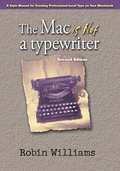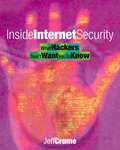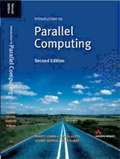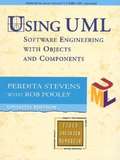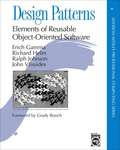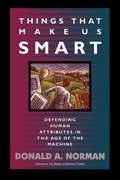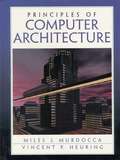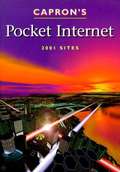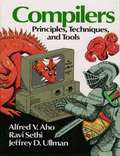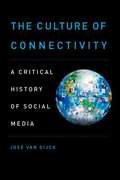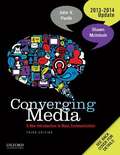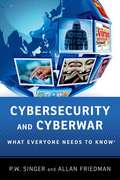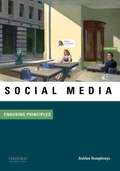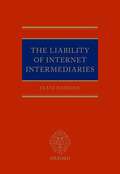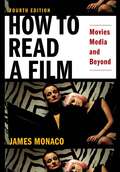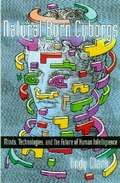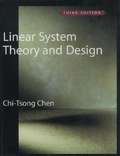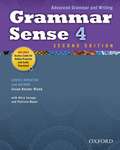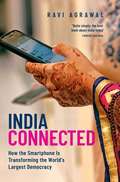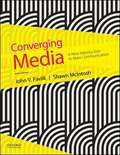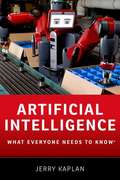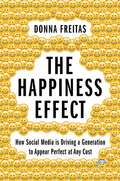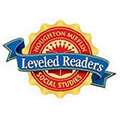- Table View
- List View
The Mac is not a Typewriter (Second Edition): A style manual for creating professional-level type on your Macintosh
by Robin WilliamsOne of the most popular Macintosh books ever written, The Mac is not a typewriter has been called the "Strunk and White of typography." Best-selling author Robin Williams's simple, logical principles for using type to produce beautiful, professional documents are as true now as they were when the original edition was published in 1989. This updated edition includes new examples and expanded information dedicated to the practical advice that made the first edition an enduring bestseller. Throughout, Robin shows you the small details that separate the pros from the amateurs: typographer versus typewriter quotation marks, en and em dashes, tabs and indents, kerning, leading, white space, widows and orphans, and hanging punctuation. If you prepare documents, you'll find The Mac is not a typewriter, Second Edition an indispensable guide. And those who read your documents will recognize the work of a pro, even if they don't know a curly quote from curly fries.
Inside Internet Security: What Hackers Don't Want You To Know
by Jeff CrumeThis book describes the underlying principles that crop up again and again in hacker attacks, and then focusses on lessons that can be learned, and on how to protect against recurrence. It is a practical reference book for anyone designing or administering a corporate or eBusiness network which runs across a number of platforms via the Internet. It aims to arm systems administrators with a thorough understanding of the problems of network security and their solutions, and thus help realize the tremendous potential of eBusiness. *practical hands-on advice on securing network systems *security checklists for each scenario *detailed pointers to other detailed information sources *in-depth theoretical background information *Multi-platform coverage *Unique external source of info on IBM systems *Wide use of diagrams and illustrations
Introduction to Parallel Computing (Second Edition)
by Ananth Grama Anshul Gupta George Karypis Vipin KumarIntroducation to Parallel Computing is a complete end-to-end source of information on almost all aspects of parallel computing from introduction to architectures to programming paradigms to algorithms to programming standards. It covers traditional Computer Science algorithms, scientific computing algorithms, and data intensive algorithms.
Using UML: Software Engineering with Objects and Components
by Perdita Stevens; Rob PooleyIt places UML in the context of the software engineering discipline as a whole, providing students with a practical understanding of good practice in software design and development. The authors present a broad view of the subject area, enabling students to see for themselves how different practices may be appropriate for different situations.
Design Patterns: Elements of Reusable Object-Oriented Software
by Erich Gamma Richard Helm Ralph Johnson John VlissidesThis book assumes you are reasonably proficient in at least one object-oriented programming language, and you should have some experience in object-oriented design as well. It's a book of design patterns that describes simple and elegant solutions to specific problems in object-oriented software design. Design patterns capture solutions that have developed and evolved over time. Hence they aren't the designs people tend to generate initially. They reflect untold redesign and recoding as developers have struggled for greater reuse and flexibility in their software. Design patterns capture these solutions in a succinct and easily applied form.
Things That Make Us Smart: Defending Human Attributes in the Age of the Machine
by Donald NormanHumans have always worked with objects to extend our cognitive powers, from counting on our fingers to designing massive supercomputers. But advanced technology does more than merely assist with thought and memory.
Computer Algorithms: Introduction to Design and Analysis
by Sara Baase Allen Van GelderDrawing upon combined decades of teaching experience, Professors Sara Baase and Allen Van Gelder have extensively revised this best seller to make it the most current and accessible choice for any algorithms course. <p><p>The new Third Edition features the addition of new topics and exercises and an increased emphasis on algorithm design techniques such as divide-and-conquer and greedy algorithms. It continues the tradition of solid mathematical analysis and clear writing style that made it so popular in previous editions.
Principles of Computer Architecture
by Miles J. Murdocca Vincent P. HeuringDesigned especially for undergraduates in computer-related disciplines, with emphasis to support the compiler, operating system, and networking courses. For a first course in computer architecture or computer organization. This text covers computer architecture at the instruction set architecture (ISA) and system design levels. Starting with foundation material on data representation and computer arithmetic, the book moves through the basic components of a computer architecture, covering topics at increasing levels of complexity up through CISC, network architecture, and parallel architecture. the authors have adopted the use of a SPARC-subset for an instructional ISA called "ARC" (A RISC Computer), which is carried through the mainstream of the book, and is complemented with platform-independent software tools that simulate the ARC ISA as well as the MIPS and x86 (Pentium) ISAs.
Capron's Pocket Internet 2001 Sites
by H. L. CapronWant to find the best sites on the Net for your topic of interest? More than 2000 carefully selected websites so start discovering!
Compilers: Principles, Techniques, and Tools
by Alfred V. Aho Ravi Sethi Jeffrey D. UllmanThe authors present updated coverage of compilers based on research and techniques that have been developed in the field over the past few years.
Artificial Intelligence (2nd edition)
by Patrick H. WinstonThis is an eagerly awaited revision of the single bestselling introduction to Artificial Intelligence ever published. It retains the best features of the earlier works including superior readability, currency, and excellence in the selection of the examples.
The Culture Of Connectivity: A Critical History Of Social Media
by Jose Van DijckSocial media has come to deeply penetrate our lives: Facebook, YouTube, Twitter and many other platforms define many of our daily habits of communication and creative production. The Culture of Connectivity studies the rise of social media in the first decade of the twenty-first century up until 2012, providing both a historical and a critical analysis of the emergence of major platforms in the context of a rapidly changing ecosystem of connective media. Such history is needed to understand how these media have come to profoundly affect our experience of online sociality. The first stage of their development shows a fundamental shift. While most sites started out as amateur-driven community platforms, half a decade later they have turned into large corporations that do not just facilitate user connectedness, but have become global information and data mining companies extracting and exploiting user connectivity. Author and media scholar Jose van Dijck offers an analytical prism to examine techno-cultural as well as socio-economic aspects of this transformation. She dissects five major platforms: Facebook, Twitter, Flickr, YouTube, and Wikipedia. Each of these microsystems occupies a distinct position in the larger ecology of connective media, and yet, their underlying mechanisms for coding interfaces, steering users, and filtering content rely on shared ideological principles. At the level of management and organization, we can also observe striking similarities between these platforms' shifting ownership status, governance strategies, and business models. Reconstructing the premises on which these platforms are built, this study highlights how norms for online interaction and communication gradually changed. "Sharing," "friending," "liking," "following," "trending," and "favoriting" have come to denote online practices imbued with specific technological and economic meanings. This process of normalization, the author argues, is part of a larger political and ideological battle over information control in an online world where everything is bound to become social. Crossing lines of technological, historical, sociological, and cultural inquiry, The Culture of Connectivity will reshape the way we think about interpersonal connection in the digital age.
Converging Media: A New Introduction to Mass Communication
by John V. Pavlik Shawn McintoshDigital media is changing the ways in which we communicate: we watch TV and movies online, call friends on computers, and read newspapers on cell phones. Placing convergence at the center of the discussion, Converging Media: A New Introduction to Mass Communication uses the technologies we employ everyday to explain our current media environment - and to project where we might be headed. Rather than discussing each media industry in isolation, Converging Media shows how each branch of media (print, visual, and audio) relates to and influences the others. This enables students to see the inextricable and dynamic relationship between converging media and traditional media formats.
Cybersecurity and Cyberwar: What Everyone Needs to Know
by P. W. Singer Allan FriedmanDependence on computers has had a transformative effect on human society. Cybernetics is now woven into the core functions of virtually every basic institution, including our oldest ones. War is one such institution, and the digital revolution's impact on it has been profound. The Americanmilitary, which has no peer, is almost completely reliant on high-tech computer systems. Given the Internet's potential for full-spectrum surveillance and information disruption, the marshaling of computer networks represents the next stage of cyberwar. Indeed, it is upon us already. The recentStuxnet episode, in which Israel fed a malignant computer virus into Iran's nuclear facilities, is one such example. Penetration into US government computer systems by Chinese hackers - presumably sponsored by the Chinese government - is another. Together, they point to a new era in the evolution ofhuman conflict. In Cybersecurity: What Everyone Needs to Know, noted experts Peter W. Singer and Allan Friedman lay out how the revolution in military cybernetics occurred and explain where it is headed. They begin with an explanation of what cyberspace is before moving on to discussions of how it can be exploitedand why it is so hard to defend. Throughout, they discuss the latest developments in military and security technology. Singer and Friedman close with a discussion of how people and governments can protect themselves. In sum, Cybersecurity is the definitive account on the subject for the educatedlayman who wants to know more about the nature of war, conflict, and security in the twenty first century.
Social Media: Enduring Principles
by Ashlee HumphreysIntegrating the role of media in society with foundational research and theory, Social Media aims to open a well-structured, well-grounded conversation about media transition and its effects. Offering a comprehensive overview of topics, it covers not only cultural issues like online identityand community, but also tackles more analytical topics like social media measurement, network analysis, and social media economics at an introductory level.
The Liability of Internet Intermediaries
by Jaani Riordan<P>There is no book dedicated to the doctrines and remedies which regulate the legal liability of internet intermediaries.<P> This is surprising, given that we live in an era in which almost all communications and transactions rely upon services provided or facilitated by such intermediaries.
How to Read a Film: Movies, Media, and Beyond
by James MonacoRichard Gilman referred to How to Read a Film as simply "the best single work of its kind." And Janet Maslin in The New York Times Book Review marveled at James Monaco's ability to collect "an enormous amount of useful information and assemble it in an exhilaratingly simple and systematic way." Indeed, since its original publication in 1977, this hugely popular book has become the definitive source on film and media. <p><p>Now, James Monaco offers a special anniversary edition of his classic work, featuring a new preface and several new sections, including an "Essential Library: One Hundred Books About Film and Media You Should Read" and "One Hundred Films You Should See." As in previous editions, Monaco once again looks at film from many vantage points, as both art and craft, sensibility and science, tradition and technology. <p><p>After examining film's close relation to other narrative media such as the novel, painting, photography, television, and even music, the book discusses the elements necessary to understand how films convey meaning, and, more importantly, how we can best discern all that a film is attempting to communicate. In addition, Monaco stresses the still-evolving digital context of film throughout--one of the new sections looks at the untrustworthy nature of digital images and sound--and his chapter on multimedia brings media criticism into the twenty-first century with a thorough discussion of topics like virtual reality, cyberspace, and the proximity of both to film.
Natural-Born Cyborgs: Minds, Technologies, and the Future of Human Intelligence
by Andrew J. ClarkCognitive scientist Clark believes we are liberating our minds, thanks to our penchant for inventing tools that extend our abilities to think and communicate, starting with the basics of pen and paper and moving on to ever more sophisticated forms of computers. In this lively and provocative treatise, Clark declares that we are, in fact, "human-technology symbionts" or "natural-born cyborgs," always seeking ways to enhance our biological mental capacities through technology, an intriguing claim he supports with a brisk history of "biotechnology mergers," which currently range from pacemakers to the way a pilot of a commercial airplane is but one component in an elaborate "biotechnological problem-solving matrix." Cell phones, Clark explains, are "a prime, if entry-level cyborg technology," as are Internet search engines. As Clark clearly and cheerfully discusses cognitive processes, how we build "better worlds to think in," opaque versus transparent technologies, and the fluidity of our sense of self and adaptation to environmental changes, he offers hope that our brainy species can use its ever-evolving
Linear System Theory and Design
by Chi-Tsong ChenAn extensive revision of the author's highly successful text, this third edition of Linear System Theory and Design has been made more accessible to students from all related backgrounds. After introducing the fundamental properties of linear systems, the text discusses design using state equations and transfer functions. In state-space design, Lyapunov equations are used extensively to design state feedback and state estimators. In the discussion of transfer-function design, pole placement, model matching, and their applications in tracking and disturbance rejection are covered. Both one-and two-degree-of-freedom configurations are used. All designs can be accomplished by solving sets of linear algebraic equations. <p><p> All results in this new edition are developed for numerical computation and illustrated using MATLAB, with an emphasis on the ideas behind the computation and interpretation of results. This book develops all theorems and results in a logical way so that readers can gain an intuitive understanding of the theorems. This revised edition begins with the time-invariant case and extends through the time-varying case. It also starts with single-input single-output design and extends to multi-input multi-output design. Striking a balance between theory and applications, Linear System Theory and Design, 3/e, is ideal for use in advanced undergraduate/first-year graduate courses in linear systems and multivariable system design in electrical, mechanical, chemical, and aeronautical engineering departments. It assumes a working knowledge of linear algebra and the Laplace transform and an elementary knowledge of differential equations.
Grammar Sense 4
by Susan KesnerGrammar Sense is a four-level discourse-based grammar series which focuses on the connection between form, meaning, and use of English structures. The series is based on the fundamental premise that English grammar is learnable and teachable if it is systematically organized and explained. Grammar Sense implements linguistic and applied linguistic research on how, where, when, and why native speakers use English structures, and how non-native speakers learn them. This series provides learners with a true understanding of how grammar is used in authentic contexts. Grammar is presented in discourse rather than in isolated sentences which allows the students to understand English grammar in real life situations.
India Connected: How the Smartphone is Transforming the World's Largest Democracy
by Ravi AgrawalIndia is connecting at a dizzying pace. In 2000, roughly 20 million Indians had access to the internet. In 2017, 465 million were online, with three new people logging on for the first time every second. By 2020, the country's online community is projected to exceed 700 million; more than a billion Indians are expected to be online by 2025. While users in Western countries progressed steadily over the years from dial-up connections on PCs, to broadband access, wireless, and now 4G data on phones, in India most have leapfrogged straight into the digital world with smartphones and affordable data plans. What effect is all this having on the ancient and traditionally rural culture dominated by family and local customs? Ravi Agrawal's book explores that very question, seeking out the nexuses of change and those swept up in them. Smartphones now influence arranged marriages, create an extension of one's social identity that moves beyond caste, bring within reach educational opportunities undreamed of a generation ago, bridge linguistic gaps, provide outlets and opportunities for start-ups, and are helping to move the entire Indian economy from cash- to credit-based. The effects are everywhere, and they are transformative. While they offer immediate access to so much for so many, smartphones are creating no Utopia in a culture still struggling with poverty, illiteracy, corruption, gender inequality, and income disparity. Internet access has provided greater opportunities to women and altered how India's outcasts interact with the world; it has also made pornography readily available and provided an echo chamber for rumor and prejudice. Under a government determined to control content, it has created tensions. And in a climate of hypernationalism, it has fomented violence and even terrorism. The influence of smartphones on the world's largest democracy is pervasive and irreversible, disruptive and creative, unsettling and compelling. Agrawal's fascinating book gives us the people and places reflecting what the internet hath wrought. India Connected reveals both its staggering dimensions and implications, illuminating how it is affecting the progress of progress itself.
Converging Media
by John V. Pavlik Shawn McIntoshIndustry. Culture. Technology. It's time they came together. From reading news on tablets to video calling on smartphones, digital media has changed the ways in which we communicate. Placing convergence at the center of the discussion, Converging Media: A New Introduction to Mass Communication, Sixth Edition, uses the technologies we employ every day to explain our current media environment--and to consider where we might be headed.
Artificial Intelligence: What Everyone Needs to Know
by Jerry KaplanOver the coming decades, Artificial Intelligence will profoundly impact the way we live, work, wage war, play, seek a mate, educate our young, and care for our elderly. It is likely to greatly increase our aggregate wealth, but it will also upend our labor markets, reshuffle our social order, and strain our private and public institutions. Eventually it may alter how we see our place in the universe, as machines pursue goals independent of their creators and outperform us in domains previously believed to be the sole dominion of humans. Whether we regard them as conscious or unwitting, revere them as a new form of life or dismiss them as mere clever appliances, is beside the point. They are likely to play an increasingly critical and intimate role in many aspects of our lives. The emergence of systems capable of independent reasoning and action raises serious questions about just whose interests they are permitted to serve, and what limits our society should place on their creation and use. Deep ethical questions that have bedeviled philosophers for ages will suddenly arrive on the steps of our courthouses. Can a machine be held accountable for its actions? Should intelligent systems enjoy independent rights and responsibilities, or are they simple property? Who should be held responsible when a self-driving car kills a pedestrian? Can your personal robot hold your place in line, or be compelled to testify against you? If it turns out to be possible to upload your mind into a machine, is that still you? The answers may surprise you.
The Happiness Effect: How Social Media is Driving a Generation to Appear Perfect at Any Cost
by Donna Freitas Christian SmithSexting. Cyberbullying. Narcissism. Social media has become the dominant force in young people's lives, and each day seems to bring another shocking tale of private pictures getting into the wrong hands, or a lament that young people feel compelled to share their each and every thought with the entire world. Have smartphones and social media created a generation of self-obsessed egomaniacs? <p>Absolutely not, Donna Freitas argues in this provocative book. And, she says, these alarmist fears are drawing attention away from the real issues that young adults are facing.
Finding Your Way Around
by Alice CaryPeople have always wanted to know where they were and how to get where they wanted to go. For many years, sailors used the stars and sun to find their way. Now sailors can figure out exactly where they are, even on a cloudy day. They can use a tool called the Global Positioning System, or GPS.
